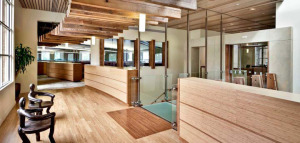Oct 21 2010
The Gordon and Betty Moore Foundation workplace has been awarded LEED® (Leadership in Energy and Environmental Design) Platinum certification—the highest level attainable—as established by the U.S. Green Building Council (USGBC) and verified by the Green Building Certification Institute (GBCI).
The Foundation’s workplace, designed by Hawley Peterson Snyder and built by Blach Construction Company, represents the eleventh project in California to be awarded the Platinum designation for Commercial Interiors (LEED-CI).
The LEED-CI rating system articulates standards for high-performance green interiors that are healthy and productive places to work, are less costly to operate and maintain, and yield a reduced environmental footprint. According to USGBC, buildings in the United States are responsible for 39% of CO2 emissions, 40% of energy consumption, 13% water consumption and 15% of GDP per year, making green building a source of significant economic and environmental opportunity. USGBC estimates that greater building efficiency can meet 85% of future U.S. demand for energy.
 Gordon and Betty Moore Foundation workplace
Gordon and Betty Moore Foundation workplace
Because environmental conservation stands as one of the Foundation’s three programmatic pillars, manifesting this mission in the building’s structure, function, and design meant working creatively to incorporate sustainability into every possible facet of renovation and reconstruction. “Our offices reflect both the technological and innovative roots of our founders, as well as our overarching conservation objective to change the ways in which people use natural resources, to conserve critical ecological systems and functions while allowing sustainable use,” said Steve McCormick, the Foundation’s president.
The Foundation’s LEED Platinum certification derives from a number of green design and construction features that positively impact the project itself and the broader community. These features include:
- Existing building reuse reduced the carbon foot print of the project by extending the usable life of what was an existing market-rate building and enhancing its performance.
- Resource demand reduction measures resulted in a construction waste diversion rate of more than 96%, a regionally manufactured material total of 40.6% including all of the new conference tables and casework, and a 72.9% total of all wood based products being Forest Stewardship Council (FSC) certified. In addition, new and refurbished restroom cores resulted in 37.4% water demand reduction.
- Energy demand reduction measures include a cool roof, window film, window shades, lighting controls, light harvesting, occupancy sensor operated emergency lighting in the stairwells, a new high efficiency boiler, Energy Star® appliances and equipment, enhanced commissioning, and ongoing measurement and verification measures.
- Indoor environmental quality was improved by providing access to natural light and views to everyone in the building, careful selection of materials and adhesives, increased ventilation, and the implementation of green cleaning protocols.
- A simple palette of natural materials helps orient and ground the space. Bamboo and cork are used in place of wood for flooring and bamboo and Kirei (sorghum straw) board are used for casework. Plaster, recycled content carpet tile, no- and low-VOC paints, FSC wood, reclaimed timber, locally harvested wood from urban forestry sources, cotton insulation, and recycled glass tile are also part of the project.
- Alternative transportation options are supported by bus stops connecting the site to the community and local train station, a well utilized employee incentive program for carpooling and use of public transportation, and the use of video conferencing to reduce travel miles.
- Flexibility for shifting program staffing requirements is built into the design so that the project fits the Foundation’s needs now and will continue to do so as it grows and changes over time.
“Buildings are fundamental to the way human systems integrate with natural systems,” said Rick Fedrizzi, President, CEO & Founding Chair, U.S. Green Building Council. “The Gordon and Betty Moore Foundation project uses natural resources efficiently and makes an immediate, positive impact on our planet, which will in turn tremendously benefit future generations.”
Mike Blach, President and CEO of Blach Construction Company, remarked, “This LEED Platinum certification represents the Foundation’s commitment to environmental conservation, and it’s been our honor to partner with the Foundation and HPS to design and build one of the greenest workplaces in the country.”
“The Foundation project was built on respect for the planet and the natural resources needed to build and operate it, respect for the people of the Foundation who use it every day, and respect for the designers, builders, and owners who worked so closely together to bring it to reality,” noted Curtis Snyder, Principal of Hawley Peterson Snyder. “It has been our privilege to be a part of this team.”
Source: http://www.blach.com/